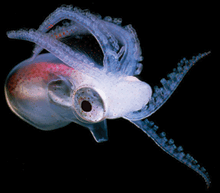 In my recent experiments using radiolabeled USS-1 donor DNAs, I was impressed by just how well naturally competent H. influenzae will slurp up USS-containing DNA. I’d read about it, but observing it myself was really something. (It reminds me a bit of the first time I “saw” Mendelian segregation when I dissected my first yeast tetrads.)
In my recent experiments using radiolabeled USS-1 donor DNAs, I was impressed by just how well naturally competent H. influenzae will slurp up USS-containing DNA. I’d read about it, but observing it myself was really something. (It reminds me a bit of the first time I “saw” Mendelian segregation when I dissected my first yeast tetrads.)The other thing that struck me, reading the antecedents of my uptake experiments, was that a large majority of taken up DNA is simply degraded and the nucleotide subunits used for DNA replication. In my experiments, while donor DNA remained intact in rec-2 cells, there was no intact donor DNA after an hour in wild-type cells. All the radiolabel was found in the chromosomal DNA.
Using linearized USS-containing plasmid donor DNA, Barouki and Smith (1985) nicely show that this chromosomal labeling is NOT dependent on recombination, as rec-1 mutant competent cells obtain similar levels of chromosomal labeling (rec-1 is the recA homolog in H. influenzae). Using restriction digestion, they also nicely show that in wild-type cells, only some of the donor DNA manages to recombine into the recipient chromosome.
The most important lanes in the above autoradiogram from Figure 3 of their paper are Lane E and Lane F, which show restriction-digested DNA after uptake in wild-type and rec-1. In Lane E (wild-type), the two arrowheads indicate the chromosomal restriction fragments indicative of transformation by the linear plasmid donor. In Lane F (rec-1), there is no appreciable transformation of the donor DNA into the chromosome (those restriction fragments are gone).
These results raise an interesting prospect: Could we interpret amount of recombination-independent radiolabeling relative to the recombination-dependent radiolabeling as a “food-to-sex” ratio? Undeniably, DNA is taken up and used by competent cells, but it’s clearly used in two different ways: Subunit recycling (food) and recombination (sex). By my eye, it seems like a lot more of the donor DNA, even in wild-type cells, is used for food than for sex.
Of course the amount of taken up DNA a cell could use for “sex” would be highly dependent on what DNA was taken up. In the case of the experiment above if homologous portions of the donor plasmid are removed, then the “sex” fragments disappear (Lanes I and J for wt and rec-1, respectively). Furthermore, the length of homologous DNA fragments taken up by competent cells is likely to matter, due to degradation during translocation and in the cytosol.
In Maughan and Redfield (2009), they show extensive natural variation among H. influenzae strains in the amount of uptake and transformation that competent cells will undertake. Do strains that can take up DNA well but fail to transform have a high food to sex ratio?
The assay that Barouki and Smith use doesn’t seem like the best way to measure a food-to-sex ratio, since the “sex” signal is somewhat buried behind the “food” signal. I wonder if there’s an experimental scheme that would allow one to measure such a ratio more accurately. Is there a way I could feed one strain’s chromosomes to another recipient strain and figure out how much DNA incorporated into chromosomes is recombination-dependent and how much is recombination-independent?
Anyway, thinking about this has led me to having a slightly clearer idea about the food versus sex hypotheses for the maintenance of natural competence by natural selection. Things are rarely black-and-white, so perhaps both models have their merits, but it seems like it might be possible to experimentally measure how much naturally competent cells use DNA for food or sex. Would this help in understanding these arguments?

Instead of doing the food-to-sex labeling ratio experiment in MIV-treated wildtype cells, we could do it in hypercompetent mutants growing in sBHI (sxy-1 or murE749). That way the cells wouldn't have been starved just before the assay.
ReplyDeleteOr we could compare the food-to-sex ratio in starved versus unstarved cells? sxy-1 in M-IV vs sBHI?
ReplyDelete